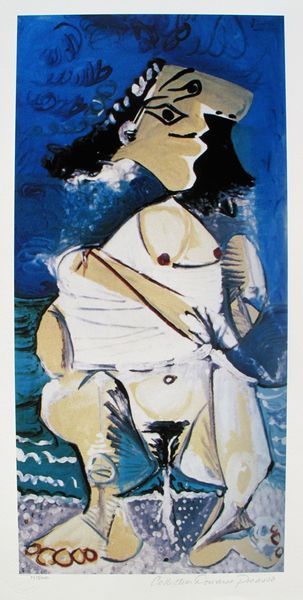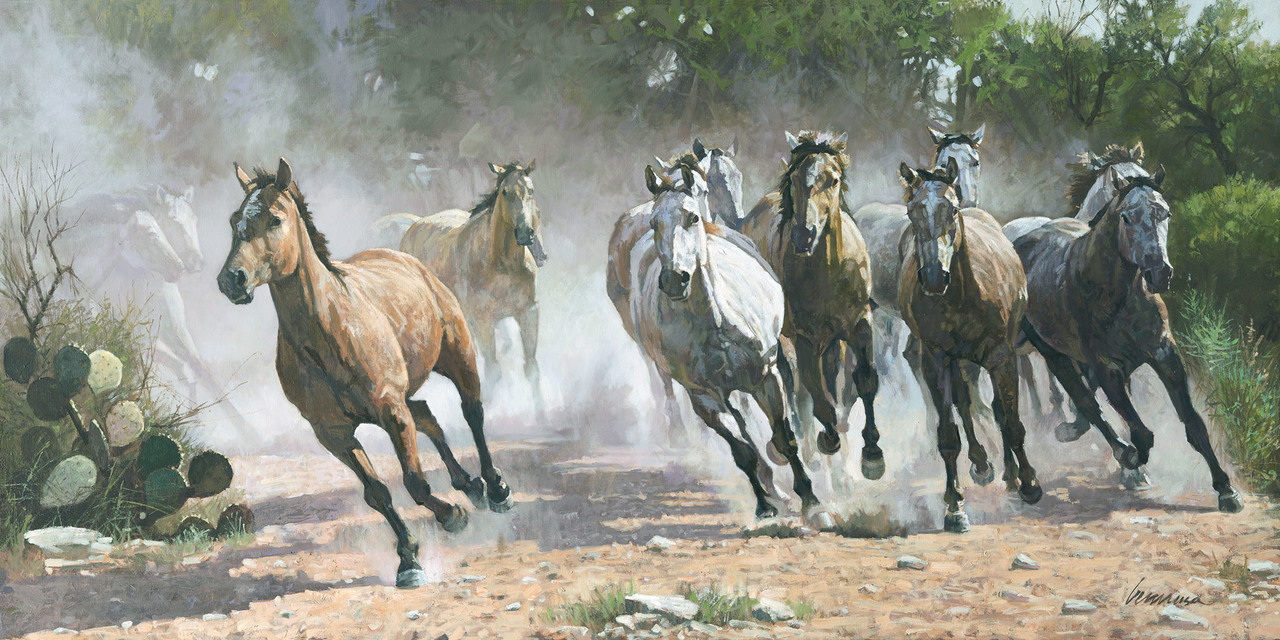
Robert Griffing Handsigned and Numbered Limited Edition Print: "One of Their Own " Out of Stock

Artist: Robert Griffing
Title: One of Their Own
Edition Size: Artist Hand Signed and Numbered to 950
Medium: Paper (Fine Art Lithograph)
Dimensions: 20" X 15"
About the Art: The history of Scotland is a turbulent story. The British isles were a confusing array of allegiances, loyalties, and blood feuds. By the time the nations of England and Scotland came into existence, the people of the two countries had been at odds with one another for hundreds of years. The final conflict came in 1745. Scots loyal to the royal House of Stuart rose in rebellion and rallied around Prince Charles Stuart. The war that ensued became known as the Jacobite rebellion of 1745. Victory would elude the Jacobites and in 1746 their army was crushed on the battlefield of Culloden Moor. England had finally and completely defeated the Scottish nation. The Bonnie Prince fled to exile and Scotland's independence slipped away with him. The years following the Battle of Culloden Moor were grim ones in Scotland. Hundreds were killed or imprisoned. The wearing of the kilt, the ownership of arms like the broad sword and pistol, and the playing of bagpipes were outlawed and punishable by death! Ancient rights to farm the land were stripped and the people were removed for more lucrative sheep herds. As a nation, Scotland was dying a slow death. By the mid 1750's rumors began to spread. The Jacobite movement was alive again. Clergymen in Scotland were preaching sedition, and despite the disarming act, English agents reported enough weapons hidden away in the Highlands to outfit an army of 10,000 men. This all came on the heels of another war between France and England. William Pitt made a revolutionary suggestion to bring the Scots into the English army! With the fighting men of the Highlands in the British army they could be used to defeat an enemy abroad and be out of England itself. The decision was made to raise the Highland regiments. Scotsmen by the thousands answered the call to arms. By 1757 these new Scottish regiments were aboard ships bound for the American colonies. For many of the men it would be the last time they would ever see their Scottish home.
Among them were the 77th Highland Regiment Of Foot commanded by Archibald Montgomery. The 77th became the backbone of General John Forbes campaign against Fort Duquesne in 1758. Throughout the long summer of '58 the Highlanders hacked their way west across the rugged Appalachian Mountains of Pennsylvania. In September of that year, men of the 77th Regiment under Major James Grant were sent to scout around Fort Duquesne. The men quickly found themselves in a deadly cross fire just a short distance from the fort. An estimated 800 French and Indians threw themselves at the Highlanders. After hours of intense fighting Major Grant found himself completely surrounded. With the dignity of a Highland gentleman, Grant surrendered. Over 300 of the original 750 men were killed, wounded or missing. What remained of the 77th marched at the head of the column a few months later when Forbes took control of the point and Fort Duquesne. As the new owners of the point prepared to defend their prize, the soldiers of the 77th buried their dead still lying among the trees where they had fallen during Grant's defeat. Within weeks the Highlanders were on their way east again to Philadelphia. From there they went on to fight the French in the West Indies and the Cherokee in the hills of the Carolinas. Many of the men of the 77th would loose their lives fighting for the King of England. After years of hard fighting, the French & Indian War ended. In the spring of 1763 the 77th was marked to be disbanded. Before the order to break up the regiment could be executed, Pontiac's War swept the frontier and the 77th was ordered to march west again. Only a hand full of the 77th were left when Bouquet met the warriors of the Ohio Valley at the decisive Battle of Bushy Run. Those that survived the bloody two day engagement limped to Fort Pitt to relieve it's besieged occupants. It was there at the point the Montgomery's 77th Highland Regiment Of Foot were ordered to disband. It was fate that brought them back to the very place they had fought so many years before. Here we see two men of the 77th as they pay their final respects to "One of their Own" on the rugged rock strewn slope now known as Grant's Hill. They quietly place a thistle upon the grave of a friend or possibly even a father, brother or cousin. After five long hard years of fighting in the most terrible conditions, the men of the 77th Highlanders were finished. Few ever returned home to Scotland.
Geo Irvin
Description: All Prints are sale priced everyday! Professionally Frame any print from our dealer gallery starting at an additional $149 and receive free shipping!
Click here to view the framing options.
Title: One of Their Own
Edition Size: Artist Hand Signed and Numbered to 950
Medium: Paper (Fine Art Lithograph)
Dimensions: 20" X 15"
About the Art: The history of Scotland is a turbulent story. The British isles were a confusing array of allegiances, loyalties, and blood feuds. By the time the nations of England and Scotland came into existence, the people of the two countries had been at odds with one another for hundreds of years. The final conflict came in 1745. Scots loyal to the royal House of Stuart rose in rebellion and rallied around Prince Charles Stuart. The war that ensued became known as the Jacobite rebellion of 1745. Victory would elude the Jacobites and in 1746 their army was crushed on the battlefield of Culloden Moor. England had finally and completely defeated the Scottish nation. The Bonnie Prince fled to exile and Scotland's independence slipped away with him. The years following the Battle of Culloden Moor were grim ones in Scotland. Hundreds were killed or imprisoned. The wearing of the kilt, the ownership of arms like the broad sword and pistol, and the playing of bagpipes were outlawed and punishable by death! Ancient rights to farm the land were stripped and the people were removed for more lucrative sheep herds. As a nation, Scotland was dying a slow death. By the mid 1750's rumors began to spread. The Jacobite movement was alive again. Clergymen in Scotland were preaching sedition, and despite the disarming act, English agents reported enough weapons hidden away in the Highlands to outfit an army of 10,000 men. This all came on the heels of another war between France and England. William Pitt made a revolutionary suggestion to bring the Scots into the English army! With the fighting men of the Highlands in the British army they could be used to defeat an enemy abroad and be out of England itself. The decision was made to raise the Highland regiments. Scotsmen by the thousands answered the call to arms. By 1757 these new Scottish regiments were aboard ships bound for the American colonies. For many of the men it would be the last time they would ever see their Scottish home.
Among them were the 77th Highland Regiment Of Foot commanded by Archibald Montgomery. The 77th became the backbone of General John Forbes campaign against Fort Duquesne in 1758. Throughout the long summer of '58 the Highlanders hacked their way west across the rugged Appalachian Mountains of Pennsylvania. In September of that year, men of the 77th Regiment under Major James Grant were sent to scout around Fort Duquesne. The men quickly found themselves in a deadly cross fire just a short distance from the fort. An estimated 800 French and Indians threw themselves at the Highlanders. After hours of intense fighting Major Grant found himself completely surrounded. With the dignity of a Highland gentleman, Grant surrendered. Over 300 of the original 750 men were killed, wounded or missing. What remained of the 77th marched at the head of the column a few months later when Forbes took control of the point and Fort Duquesne. As the new owners of the point prepared to defend their prize, the soldiers of the 77th buried their dead still lying among the trees where they had fallen during Grant's defeat. Within weeks the Highlanders were on their way east again to Philadelphia. From there they went on to fight the French in the West Indies and the Cherokee in the hills of the Carolinas. Many of the men of the 77th would loose their lives fighting for the King of England. After years of hard fighting, the French & Indian War ended. In the spring of 1763 the 77th was marked to be disbanded. Before the order to break up the regiment could be executed, Pontiac's War swept the frontier and the 77th was ordered to march west again. Only a hand full of the 77th were left when Bouquet met the warriors of the Ohio Valley at the decisive Battle of Bushy Run. Those that survived the bloody two day engagement limped to Fort Pitt to relieve it's besieged occupants. It was there at the point the Montgomery's 77th Highland Regiment Of Foot were ordered to disband. It was fate that brought them back to the very place they had fought so many years before. Here we see two men of the 77th as they pay their final respects to "One of their Own" on the rugged rock strewn slope now known as Grant's Hill. They quietly place a thistle upon the grave of a friend or possibly even a father, brother or cousin. After five long hard years of fighting in the most terrible conditions, the men of the 77th Highlanders were finished. Few ever returned home to Scotland.
Geo Irvin
Description: All Prints are sale priced everyday! Professionally Frame any print from our dealer gallery starting at an additional $149 and receive free shipping!
Click here to view the framing options.
Availability: Print only orders usually ship in 3-9 days. "Custom Framed" products are made to order by craftsman, so additional time is required. Please allow 3-4 weeks for delivery.
















